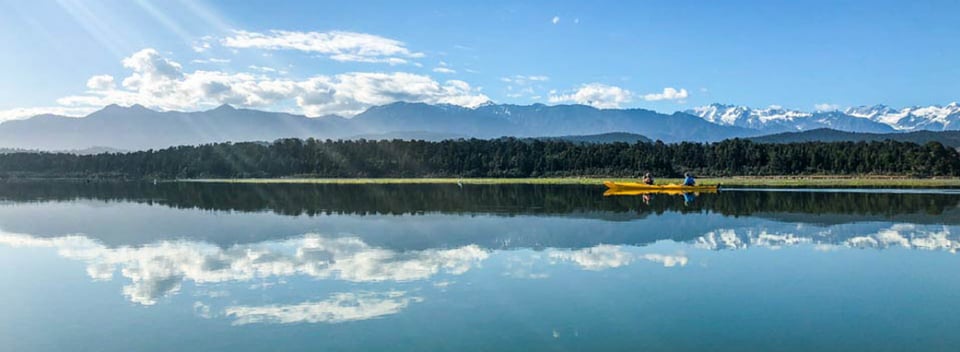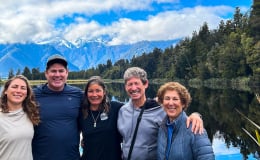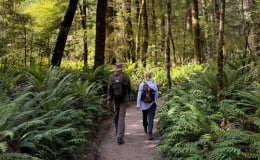
10 Best Places to Kayak in New Zealand

Kayaking in New Zealand
New Zealand is the home of adventure and a land of plentiful water, with hundreds of beautiful lakes, rivers, and coastlines dotted with pristine beaches. Home to a vast array of interesting birds and marine wildlife, one of the best ways to enjoy New Zealand’s scenery and get up close to the wildlife is by getting on the water and taking a kayak for a paddle.
Nothing says "New Zealand adventure" quite like the freedom of kayaking so here we have put together our favourite 10 places to kayak in New Zealand. Now all that’s left for you to do is get out and explore them!
1. Bay of Islands
The stunning Bay of Islands in Northland offers a tropical marine paradise, best explored from the water. There are several kayak rental and tour operators throughout the Bay of Islands from which you can rent a kayak for a couple of hours, or embark on a multi-day camping expedition to thoroughly explore the area. There are many great half-day trips from Paihia and Russell, or venture further afield to the outer islands such as Urupukapuka.
2. Cathedral Cove, Coromandel
Avoid the busy walking track to Cathedral Cove and hassle of finding a carpark, and instead enjoy a peaceful couple of hours on the water. You can rent a kayak from Hahei Beach, and from there it is a pleasant paddle around the headland, which takes roughly an hour each way. The trip is best done in the morning when the sea is usually the calmest, and generally Cathedral Cove is the least busy at this time as well.
Our Sweet North Tour includes a fully guided kayak tour to Cathedral Cove, where your guide will lead you through secluded sea caves and introduce you to the local marine life, and you will have time to land on the beach at Cathedral Cove and snap some photos before making your way back to Hahei for a tasty lunch on the beach.

3. Taupo Maori Rock Carvings
The impressive Ngatoroirangi Mine Bay Maori rock carvings, carved into a towering cliff face above Lake Taupo, are only accessible by boat or kayak. Paddle across New Zealand’s largest lake with the volcanoes of Tongariro National Park as your backdrop, and take in what is considered to be one of New Zealand’s most extraordinary artworks. The trip takes about 3 hours, and is best experienced with a local guide who will share the fascinating history of the area with you.
4. Abel Tasman
Abel Tasman National Park is New Zealand’s most popular kayaking destination, and rightfully so! Golden sandy beaches, crystal clear water, and lush native bush make for a haven to explore by kayak and on foot. Many of the campsites in the National Park are only accessible by kayak or boat, making it the perfect spot to take an overnight kayaking trip. There are many different options for all kayaking abilities, ranging from an hour to several days.
A day trip to the Abel Tasman is easily done from the nearby city of Nelson, and it is possible to do a combination of kayaking, walking the Abel Tasman Track, and taking a catamaran cruise along the coast all in one day! Our Masterpiece and Kiwi Classic Tours both have a free day in Nelson halfway through the tour, which is the perfect opportunity to take a day trip to the Abel Tasman. Chat to your guides who can help you organise your day trip.

5. Marlborough Sounds
The Marlborough region frequently boasts the most sunshine hours in the country per year, making it the ideal place to go kayaking! There are numerous areas of the Sounds where kayaks can be rented, but the Queen Charlotte Sound is the most popular due to the easy access from Picton.
Our favourite Marlborough Sounds kayaking trip is from Picton to Lochmara Bay, a paddle that takes about 2 hours. This Lochmara kayaking experience is included in our Masterpiece Tour, and stays at Lochmara Lodge overnight, giving you time to explore the Queen Charlotte Track as well. Other popular spots to kayak in the Marlborough Sounds include Queen Charlotte Sound from Anakiwa, or Pelorus Sound from Havelock.
6. Okarito Lagoon
Hidden down a side road off the main highway along the South Island’s West Coast is the tiny township of Okarito. The Okarito Lagoon is the largest unmodified wetland in New Zealand, and is home to more than 70 species of birds including the extremely rare kotuku, or white heron. If you’re a bird lover and nature enthusiast, this is the ultimate place to go kayaking due to the huge variety of birds that are seen on the lagoon. You will spend an afternoon paddling around this secluded lagoon as part of our World Heritage Walking Tour.

7. Lake Mapourika
With the tallest mountains of New Zealand’s Southern Alps towering above, Lake Mapourika has one of the most impressive backdrops to kayak under in the country. Located near Franz Josef, Lake Mapourika is home to a large number of bird species, and its often-glassy surface frequently reflects a perfect image of the mountains. A couple of hours spent kayaking here is a must-do addition to any visit to Franz Josef, and is included in both our Masterpiece and Kiwi Classic Tours.
8. Lake Wanaka
A crowd favourite with the locals, Lake Wanaka is one of the most popular holiday destinations for Kiwis. Ruby Island is only a short paddle from the main beach in Wanaka township, and makes a great half-day trip. Pack a picnic and have lunch on the island before cruising back to Wanaka. You can also paddle down the Clutha River from the outlet of Lake Wanaka to the settlement of Albert Town, or venture further out into the lake for a full-day adventure.
9. Milford Sound
Milford Sound is one of the most photographed destinations in New Zealand thanks to its dramatic towering peaks that plunge directly to the ocean. Embarking on a kayak tour is the best way to immerse yourself in the landscape, and gives perspective to how impressive the mountains of Fiordland are. Most overnight boat cruises on Milford Sound include an afternoon of kayaking from the boat, one of many reasons to spend the night on Milford Sound!

10. Doubtful Sound
The lesser-known sibling to Milford Sound, Doubtful Sound is just as scenic and awe-inspiring. It is more remote and a little harder to get to, meaning you will find fewer people here and more serenity. You can rent kayaks or join a guided tour, and enjoy the peace and quiet of remote Fiordland National Park. Our World Heritage Walking Tour takes you into not only Milford Sound, but Doubtful Sound as well.
Most of our South Island tours include a guided kayak in one of the locations described above. If kayaking is your thing (or if you’re new to kayaking but would love to try it out), our Masterpiece Tour includes both the Lochmara Bay kayak in the Marlborough Sounds and a paddle on Lake Mapourika on the West Coast, as well as the option to explore the Abel Tasman by kayak on your free day! For more information on our New Zealand Trails Tours, request a FREE COPY OF OUR BROCHURE today!







